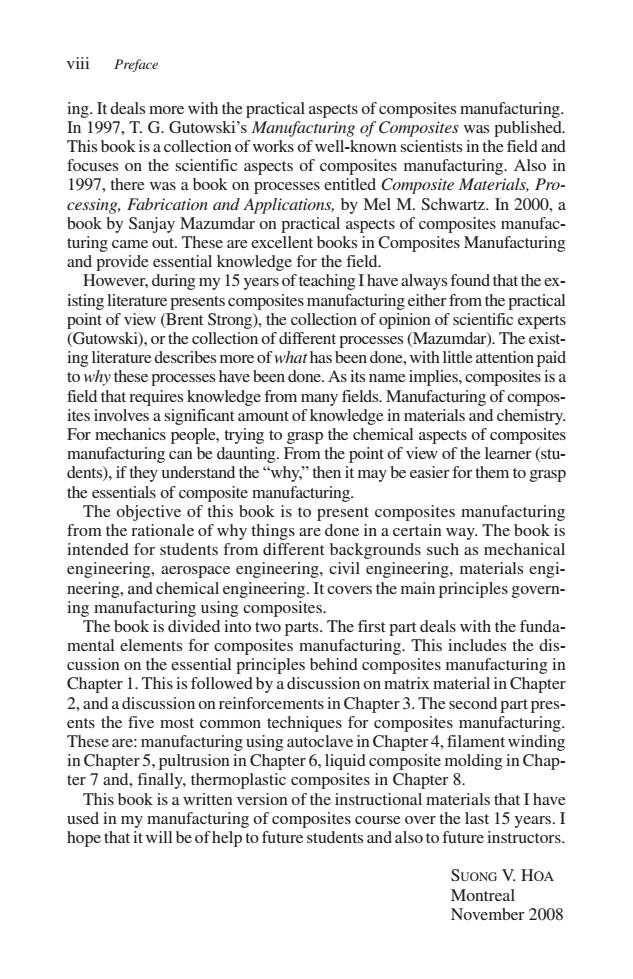正在加载图片...

vii Preface ing.It deals more with the practical aspects of composites manufacturing In 1997,T.G.Gutowski's Manufacturing of Composites was published This book is a collection of works of well-known scientists in the field and focuses on the scientific aspects of composites manufacturing.Also in 1997,there was a book on processes entitled Composite Materials,Pro- cessing,Fabrication and Applications,by Mel M.Schwartz.In 2000,a book by Sanjay Mazumdar on practical aspects of composites manufac- turing came out.These are excellent books in Composites Manufacturing and provide essential knowledge for the field. However,during my 15 years of teaching I have always found that the ex- isting literature presents composites manufacturing either from the practical point of view (Brent Strong),the collection of opinion of scientific experts (Gutowski),or the collection of different processes(Mazumdar).The exist- ing literature describes more of what has been done,with little attention paid to why these processes have been done.As its name implies,composites is a field that requires knowledge from many fields.Manufacturing of compos- ites involves a significant amount of knowledge in materials and chemistry. For mechanics people,trying to grasp the chemical aspects of composites manufacturing can be daunting.From the point of view of the learner(stu- dents),if they understand the"why,"then it may be easier for them to grasp the essentials of composite manufacturing. The objective of this book is to present composites manufacturing from the rationale of why things are done in a certain way.The book is intended for students from different backgrounds such as mechanical engineering,aerospace engineering,civil engineering,materials engi- neering,and chemical engineering.It covers the main principles govern- ing manufacturing using composites. The book is divided into two parts.The first part deals with the funda- mental elements for composites manufacturing.This includes the dis- cussion on the essential principles behind composites manufacturing in Chapter 1.This is followed by a discussion on matrix material in Chapter 2,and a discussion on reinforcements in Chapter 3.The second part pres- ents the five most common techniques for composites manufacturing. These are:manufacturing using autoclave in Chapter 4,filament winding in Chapter 5,pultrusion in Chapter 6,liquid composite molding in Chap- ter 7 and,finally,thermoplastic composites in Chapter 8. This book is a written version of the instructional materials that I have used in my manufacturing of composites course over the last 15 years.I hope that it will be of help to future students and also to future instructors. SUONG V.HOA Montreal November 2008ing. It deals more with the practical aspects of composites manufacturing. In 1997, T. G. Gutowski’s Manufacturing of Composites was published. This book is a collection of works of well-known scientists in the field and focuses on the scientific aspects of composites manufacturing. Also in 1997, there was a book on processes entitled Composite Materials, Processing, Fabrication and Applications, by Mel M. Schwartz. In 2000, a book by Sanjay Mazumdar on practical aspects of composites manufacturing came out. These are excellent books in Composites Manufacturing and provide essential knowledge for the field. However, during my 15 years of teaching I have always found that the existing literature presents composites manufacturing either from the practical point of view (Brent Strong), the collection of opinion of scientific experts (Gutowski), or the collection of different processes (Mazumdar). The existing literature describes more ofwhat has been done, with little attention paid towhy these processes have been done. As its name implies, composites is a field that requires knowledge from many fields. Manufacturing of composites involves a significant amount of knowledge in materials and chemistry. For mechanics people, trying to grasp the chemical aspects of composites manufacturing can be daunting. From the point of view of the learner (students), if they understand the “why,” then it may be easier for them to grasp the essentials of composite manufacturing. The objective of this book is to present composites manufacturing from the rationale of why things are done in a certain way. The book is intended for students from different backgrounds such as mechanical engineering, aerospace engineering, civil engineering, materials engineering, and chemical engineering. It covers the main principles governing manufacturing using composites. The book is divided into two parts. The first part deals with the fundamental elements for composites manufacturing. This includes the discussion on the essential principles behind composites manufacturing in Chapter 1. This is followed by a discussion on matrix material in Chapter 2, and a discussion on reinforcements in Chapter 3. The second part presents the five most common techniques for composites manufacturing. These are: manufacturing using autoclave in Chapter 4, filament winding in Chapter 5, pultrusion in Chapter 6, liquid composite molding in Chapter 7 and, finally, thermoplastic composites in Chapter 8. This book is a written version of the instructional materials that I have used in my manufacturing of composites course over the last 15 years. I hope that it will be of help to future students and also to future instructors. SUONG V. HOA Montreal November 2008 viii Preface